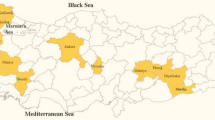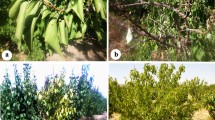Abstract
During the late summer-early autumn of 2002, surveys were carried out in Turkey to determine the presence of phytoplasma diseases in fruit trees. Phytoplasmas were detected and characterized by PCR-RFLP analysis and TEM technique in stone fruit and pear trees in the eastern Mediterranean region of the country. Six out of 24 samples, including almond, apricot, peach, pear and plum, gave positive results in PCR assays. RFLP analysis usingSspI andBsaAI enzymes of PCR products obtained with primer pair f01/r01 enabled identification of the phytoplasmas involved in the diseases. Stone fruit trees, including a local apricot variety (‘Sakıt’) and a pear sample, were found to be infected with European stone fruit yellows (ESFY, 16SrX-B) and pear decline (PD, 16SrX-C) phytoplasmas, respectively. This is the first report in Turkey of PD phytoplasma infecting pear and of ESFY phytoplasma infecting almond, apricot, myrobalan plum and peach; ESFY phytoplasma infecting Japanese plum was previously reported.
Similar content being viewed by others
References
Abou-Jawdah, Y., Dakhil, H., El-Mehtar, S. and Lee, I.-M. (2003) Almond witches’-broom phytoplasma: a potential threat to almond, peach, and nectarine.Can. J. Plant Pathol. 25:28–32.
Abou-Jawdah, Y., Karakashian, A., Sobh, H., Martini, M. and Lee, I.-M. (2002) An epidemic of Almond witches’-broom in Lebanon: classification and phylogenetic relationships of the associated phytoplasma.Plant Dis. 86:477–484.
Ahrens, U. and Seemüller, E. (1992) Detection of plant pathogenic mycoplasmalike organisms by a polymerase chain reaction that amplifies a sequence of the 16S rRNA gene.Phytopathology 82:828–832.
Anıl, Ş. (2001) Turkey. State of the art for the certification in the Mediterranean-Country Reports (Chapter III).in: Options Méditerranéennes, Serie B: Studies and Research, No: 35, Production and Exchange of Virus-free Plant Propagating Material in the Mediterranean Region. CIHAM/IAMB. ISBN: 2-85352-231-9. pp. 141–150.
Blomquist, C.L. and Kirkpatrick, B.C. (2002) Identification of phytoplasma taxa and insect vectors of peach yellow leaf roll disease in California.Plant Dis. 759–763.
Carraro, L., Ferrini, F., Ermacora, P. and Loi, N. (2002) Role of wildPrunus species in the epidemiology of European stone fruit yellows.Plant Pathol. 51:513–517.
Carraro, L., Osler, R., Loi, N., Ermacora, P. and Refatti, E. (1998) Transmission of European stone fruit yellows phytoplasma byCacopsylla pruni.J. Plant Pathol. 80:233–239.
Carraro, L., Olser, R., Loi, N., Ermacora, P. and Refatti, E. (2001) Fruit tree phytoplasma diseases diffused in nature by psyllids.Acta Hortic. 550:345–350.
Cornaggia, D., Gentit, P., Boyé, R. and Desvignes, J.C. (1995) A new phytoplasma disease of apricot trees: the peach vein clearing.Acta Hortic. 386:448–451.
Davies, D.L., Guise, C.M. and Adams, A.N. (1992) Parry’s disease of pears is similar to pear decline and is associated with mycoplasma-like organisms transmitted byCacopsylla pyricola.Plant Pathol. 41:195–203.
Deng, S. and Hiruki, C. (1991) Amplification of 16S rRNA genes from culturable and non-culturable mollicutes.J. Microbiol. Meth. 14:53–61.
Favali, M.A., Musetti, R., Ragozzino, A. and Camele, I. (1990) A study on peach decline. II. Ultrastructural study.Riv. Patol. Veg. (IV) 26:11–22.
Giunchedi, L., Poggi Pollini, C. and Credi, R. (1983) Susceptibility of stone fruit trees to the Japanese plumtree decline causal agent.Acta Hortic. 130:285–290.
Jarausch, W., Saillard, C., Braquaire, J.M., Garnier, M. and Dosba, F. (2000) PCR-RFLP and sequence analysis of a non-ribosomal fragment for genetic characterization of European stone fruit yellows phytoplasmas infecting variousPrunus species.Mol. Cell. Probes 14:171–179.
Jensen, D.D., Griggs, W.H., Gonzales, C.Q. and Schneider, H. (1964) Pear decline virus transmission by pear psylla.Phytopathology 54:1346–1351.
Lee, I.-M., Gundersen-Rindal, D.E., Davis, R.E. and Bartoszyk, I.M. (1998) Revised classification scheme of phytoplasmas based on RFLP analyses of rRNA and ribosomal protein gene sequences.Int. J. Syst. Bacteriol. 48:1153–1169.
Lemoine, J. (1991) Dépérissement du poirier: role dePsylla pyri dans sa dissemination.Arboric. Fruit. 442:28–32.
Lorenz, K.H., Dosba, F., Poggi Pollini, C., Llacer, G. and Seemüller, E. (1994) Phytoplasma diseases ofPrunus species in Europe are caused by genetically similar organisms.Z. PflanzenKr. PflanzenSchutz 101:567–575.
Lorenz, K.H., Schneider, B., Ahrens, U. and Seemüller, E. (1995) Detection of apple proliferation and pear decline phytoplasmas by PCR amplification of ribosomal and non ribosomal DNA.Phytopathology 85:771–776.
Malisano, G., Firrao, G. and Locci, R. (1996) 16S rDNA-derived oligonucleotide probes for the differential diagnosis of plum leptonecrosis and apple proliferation phytoplasmas.EPPO Bull. 26:421–428.
Marcone, C., Ragozzino, A. and Seemüller, E. (1996) European stone fruit yellows phytoplasma as the cause of peach vein enlargement and other yellows and decline diseases of stone fruits in Southern Italy.J. Phytopathol. 144:559–564.
Morvan, G. (1977) Apricot chlorotic leaf roll.EPPO Bull. 7:37–55.
Musetti, R. and Favali, M.A. (1999) Histological and ultrastructural comparative study betweenPrunus varieties of different susceptibility to plum leptonecrosis.Cytobios 99:73–82.
Musetti, R., Favali, M.A., Carraro, L. and Osler, R. (1992) An attempt to differentiate by microscopic methods two plant mycoplasma-like organisms.Cytobios 72:71–82.
Musetti, R., Favali, M.A., Carraro, L. and Osler, R. (1994) Histological detection of mycoplasma-like organisms causing leptonecrosis in plum trees.Cytobios 78:81–90.
Navrátil, M., Válová P., Fialová, R., Petrová, K., Poncarová-Vorácková Z., Fránová, J.et al. (2001) Survey for stone fruit phytoplasmas in the Czech Republic.Acta Hortic. 550:377–382.
Paltrinieri, S., Martini, M., Stefani, E., Pondrelli, M., Fideghelli, C. and Bertaccini, A. (2000) Phytoplasma infection in peach and cherry in Italy.Acta Hortic. 550:365–370.
Poggi Pollini, C., Giunchedi, L. and Gambin, E. (1993) Presence of mycoplasma-like organisms in peach trees in Northern-Central Italy.Phytopathol. Mediterr. 32:188–192.
Schneider, B., Seemüller, E., Smart, C. and Kirkpatrick, B.C. (1995) Phylogenetic classification of plant pathogenic mycoplasmalike organisms or phytoplasmas.in: Razin, S. and Tully, J.G. [Eds.] Molecular and Diagnostic Procedures in Mycoplasmology. Academic Press, San Diego, CA, USA. pp. 369–380.
Seemüller, E. (1992) Pear decline.in: Kumar, J., Chaube, H.S., Singh, U.S. and Mukhopadhyay, A.N. [Eds.] Plant Diseases of International Importance. Prentice Hall, Englewood Cliffs, NJ, USA. pp. 308–344.
Author information
Authors and Affiliations
Corresponding author
Additional information
http://www.phytoparasitica.org posting July 21, 2005.
Rights and permissions
About this article
Cite this article
Sertkaya, G., Martini, M., Ermacora, P. et al. Detection and characterization of phytoplasmas in diseased stone fruits and pear by PCR-RFLP analysis in Turkey. Phytoparasitica 33, 380–390 (2005). https://doi.org/10.1007/BF02981306
Received:
Revised:
Accepted:
Issue Date:
DOI: https://doi.org/10.1007/BF02981306




